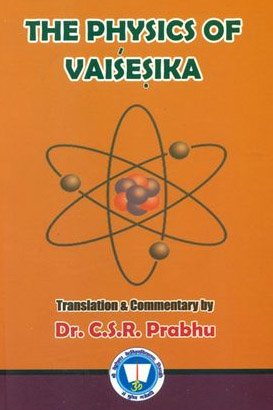Visheshaguna, Viśeṣaguṇa, Vishesha-guna: 7 definitions
Introduction:
Visheshaguna means something in Hinduism, Sanskrit. If you want to know the exact meaning, history, etymology or English translation of this term then check out the descriptions on this page. Add your comment or reference to a book if you want to contribute to this summary article.
The Sanskrit term Viśeṣaguṇa can be transliterated into English as Visesaguna or Visheshaguna, using the IAST transliteration scheme (?).
In Hinduism
Vaisheshika (school of philosophy)
Source: Shodhganga: A study of Nyāya-vaiśeṣika categories (vaisesika)Viśeṣaguṇa (विशेषगुण) or simply Viśeṣa refers to “special qualities” and represents a classification of the twenty-four guṇas (qualities) according to the Dīpikā on Tarkasaṃgraha.—The twenty-four guṇas are divided into sāmānya-guṇas and viśeṣa-guṇas. Sāmānya-guṇas (general qualities) are those which abide in two or more substances. Viśeṣa-guṇas (special qualities) are those which abide in one dravya only and not in two or more substances. Annaṃbhaṭṭa defines viśeṣa-guṇa and sāmānya-guṇa in his Dīpikā on Tarkasaṃgraha. Praśastapāda also mentions about these in his Praśastapādabhāṣya on the Vaiśeṣikadarśanam.

Vaisheshika (वैशेषिक, vaiśeṣika) refers to a school of orthodox Hindu philosophy (astika), drawing its subject-matter from the Upanishads. Vaisheshika deals with subjects such as logic, epistemology, philosophy and expounds concepts similar to Buddhism in nature
Languages of India and abroad
Sanskrit dictionary
Source: DDSA: The practical Sanskrit-English dictionaryViśeṣaguṇa (विशेषगुण).—
1) a special or distinguishing property.
2) (in phil.) such guṇa as is not produced (like saṃyoga, pṛthaktva &c.) by the union of two things.
Derivable forms: viśeṣaguṇaḥ (विशेषगुणः).
Viśeṣaguṇa is a Sanskrit compound consisting of the terms viśeṣa and guṇa (गुण).
Source: Cologne Digital Sanskrit Dictionaries: Shabda-Sagara Sanskrit-English DictionaryViśeṣaguṇa (विशेषगुण).—m.
(-ṇaḥ) An object of a single and distinct kind as the soul, mind, time, place, and the atoms of earth, water, light and air. E. viśeṣa and guṇa property.
Source: Cologne Digital Sanskrit Dictionaries: Benfey Sanskrit-English DictionaryViśeṣaguṇa (विशेषगुण).—m. a special quality, Bhāṣāp. 26, 89; 90.
Viśeṣaguṇa is a Sanskrit compound consisting of the terms viśeṣa and guṇa (गुण).
Source: Cologne Digital Sanskrit Dictionaries: Monier-Williams Sanskrit-English Dictionary1) Viśeṣaguṇa (विशेषगुण):—[=vi-śeṣa-guṇa] [from vi-śeṣa > vi-śiṣ] m. a special or distinct quality, [Nīlakaṇṭha]
2) [v.s. ...] (in [philosophy]) a substance of a distinct kind (as soul, time, space, ether, and the five atoms enumerated above), [Horace H. Wilson]
Source: Cologne Digital Sanskrit Dictionaries: Yates Sanskrit-English DictionaryViśeṣaguṇa (विशेषगुण):—[viśeṣa-guṇa] (ṇaḥ) 1. m. Any indivisible or unique object.
Sanskrit, also spelled संस्कृतम् (saṃskṛtam), is an ancient language of India commonly seen as the grandmother of the Indo-European language family (even English!). Closely allied with Prakrit and Pali, Sanskrit is more exhaustive in both grammar and terms and has the most extensive collection of literature in the world, greatly surpassing its sister-languages Greek and Latin.
Kannada-English dictionary
Source: Alar: Kannada-English corpusViśēṣaguṇa (ವಿಶೇಷಗುಣ):—[noun] a special or distinguishing trait, feature or quality; a peculiarity; a characteristic; speciality.
Kannada is a Dravidian language (as opposed to the Indo-European language family) mainly spoken in the southwestern region of India.
See also (Relevant definitions)
Partial matches: Vishesha, Guna.
Query error!
Full-text: Samanya, Samanyaguna, Shatapadartha, Yogyavisheshagunavicara, Visheshatva, Vishesha, Avyapyavritti.
Relevant text
Search found 17 books and stories containing Visheshaguna, Viśeṣa-guṇa, Visesa-guna, Viśeṣaguṇa, Visesaguna, Viśēṣaguṇa, Vishesha-guna; (plurals include: Visheshagunas, guṇas, gunas, Viśeṣaguṇas, Visesagunas, Viśēṣaguṇas). You can also click to the full overview containing English textual excerpts. Below are direct links for the most relevant articles:
Nyaya-Vaisheshika categories (Study) (by Diptimani Goswami)
Different Types of Quality (Introduction) < [Chapter 4 - Quality and Action]
Substance (5): Ākāśa (Ether) < [Chapter 3 - Dravya (Substance)]
Qualities (1): Rūpa (Colour) < [Chapter 4 - Quality and Action]
Padarthadharmasamgraha and Nyayakandali (by Ganganatha Jha)
Text 131 < [Chapter 6a - On Qualities]
Text 130 < [Chapter 6a - On Qualities]
Text 41: On Ākāśa < [Chapter 5 - Of the Mahābhūtas (Ultimate Material Substances)]
Sahitya-kaumudi by Baladeva Vidyabhushana (by Gaurapada Dāsa)
Text 10.103 [Vyatireka] < [Chapter 10 - Ornaments of Meaning]
Studies in Indian Literary History (by P. K. God)
45. A Topical Analysis of the Bhojana-Kutuhala < [Volume 2 (1954)]
A comparative study between Buddhism and Nyaya (by Roberta Pamio)
3.4. Perception according to others < [Chapter 4 - The Nyāya Theory of Perception]
International Ayurvedic Medical Journal
Pachamahabhuta siddanta: application of panchabhoutika chikitsa in the management of kusta < [2014, Issue III May-June]
Physiological aspect of samanya vishesha siddhanta in chikitsa < [2018, Issue X, October]
Conceptual and clinical study of snigdha, guru and ushna guna in managing sandhigata vata with matra vasti < [2016, Issue IX September]